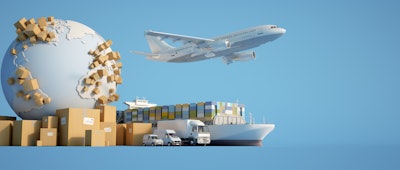
We live in a global economy, where raw materials and finished goods often travel thousands of miles before reaching homes. In the automotive industry, roughly 30,000 components come together to build a vehicle.
During uncertain times, one thing remains true, lots of parts and pieces must travel long distances for people to get the goods they want. A network of planes, trains and automobiles (and boats) make this possible – connecting raw materials in one corner of the globe with the factory that can process them, and then eventually to the endpoint: the consumer who buys the finished product.
Over the past few years, snags in the supply chain have been in the headlines for a variety of reasons, from shortages of baby formula to feminine products.
Breaking the chain: Supply chain disruptions plague all industries
Supply chain disruptions can be caused by a variety of factors. The COVID-19 pandemic hit the manufacturing and construction industries especially hard. Labor shortages have left companies struggling to hire and retain workers, meanwhile, strikes continue to threaten transportation lines.
Adding to the geopolitical challenges is climate change. This past summer, the Mississippi River dried up, and with it went the ability to move freight along the water route. In October 2022, there was a backup of over 2,000 barges on the lower Mississippi River. Low water levels also limit the amount of cargo ships can carry without bottoming out in the shallower river. Meanwhile, the same thing is happening annually in Europe as Rhine River levels drop and limit shipping ability as a result.
On the opposite end of the spectrum, sea levels have been rising at a faster rate since about 1850 and that presents a challenge to port infrastructure. Port engineers must consider moving their operations to higher ground or inland to keep them operational.
Just add water: Global trade depend on water routes to move goods
Water is vital to global trade; according to the World Economy Forum, 90% of the products that move around the globe travel by ocean and water. When these water routes are threatened, alternative routes must be utilized and can introduce additional unexpected costs.
Rail is often used as a backup when water routes become unavailable, but potential rail strikes have made that an unreliable alternative. Trucking is another alternative, and that option requires factoring in fleet availability, driver availability, fuel costs and clear weather along transport routes. The trucking industry is not immune to disruptions either; this past fall, the trucking industry saw hundreds of truckers go on strike in New England.
No matter which alternative routes are selected, there will be pros and cons – and a lack of connectivity between siloed data cripples any response.
Find a better way: Full visibility allows for transit agility
Supply chain resiliency and logistics agility is possible if routes are diversified, and siloed data sources are integrated across the entire ecosystem to track factors associated with various route options. To maintain clear and steady supply chains, transportation routes must be diversified, with both secondary and tertiary alternatives. When these alternative routes are being utilized, visibility and connectivity across the entire supply chain is crucial for success.
As the supply chain becomes more complex to answer consumers’ needs and respond to geopolitical, climate and social challenges, action without visibility across the ecosystem can remove any semblance of organized tracking or transparency. Full visibility across the ecosystem is required to understand the opportunities and risks of various transportation options. This sets up logistics companies to overcome challenges as they arise. With prior planning, alternative routes can be created and tracked to achieve logistics agility.
Companies must do two things to ensure logistics agility, and therefore improve their supply chain management. First, they must find alternative routes and understand the pros and cons of each alternative. To do this logistics planners must determine which datasets need to be monitored and reviewed to ensure shifting from one transportation method to another does not mean higher costs or greater delays. Second, they must gain full visibility into their supply chain, to know where raw materials and products are at any point along their production and delivery journey. This can only be done with full integration of all data sources.
Ecosystem enablement means more resilient and on-time supply chains
Circling back to our example of transit snarls on the Rhine - logistics firms can expect water levels to lower in the summer and fall months and should plan to have alternative supply routes on standby during those times. They also need to consider the fact that alternative routes may take longer or be more costly, and what that means for their business.
Full integration of data across the lifecycles of a product provides an awareness of the availability of transit options, as well as the pros and cons of each alternative, giving supply chain planners the insight they need to avoid transportation snags.
Transportation snarls in the supply chain are inevitable, but the delays can be minimized when agile, traceable alternatives are available. The best way to avoid seasonal transportation challenges is by planning ahead and communicating changes across the ecosystem to enable all partners to make the best decisions possible. This will also allow organizations to react faster.
With more resilient transportation strategies, products are more likely to arrive on time, preventing costly late fees and improving relationships with customers and trading partners.




















